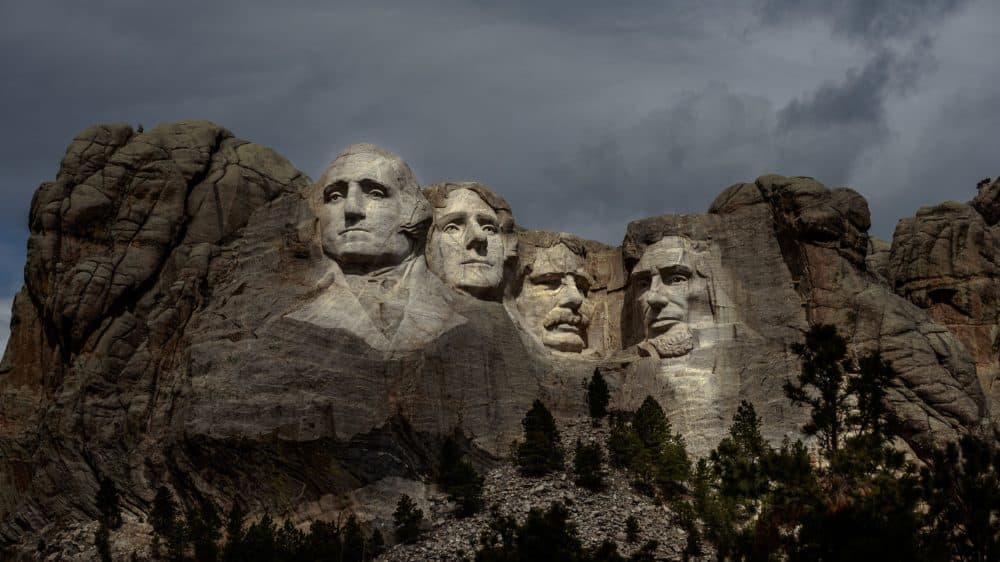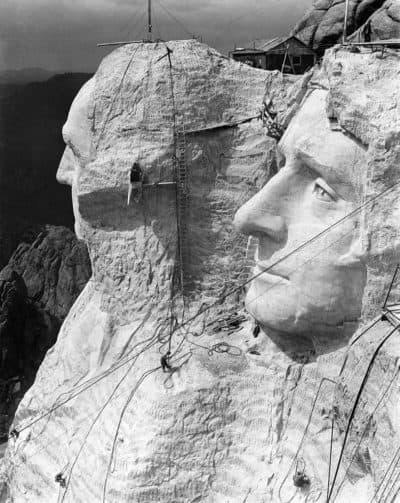Advertisement
Mount Rushmore Historian: Monument 'Is Like A Rorschach, It Says Different Things To Different People'
Resume
Fireworks over the sculptures of presidents George Washington, Thomas Jefferson, Theodore Roosevelt and Abraham Lincoln are set to dazzle high above Mount Rushmore for the first time in a decade.
In a visit to South Dakota, President Trump plans to kick off Fourth of July celebrations on Friday at Mount Rushmore, a national monument unveiled by Franklin D. Roosevelt.
Trump's visit comes amid a national debate over the future of Confederate statues and monuments across the country. This controversy also applies to Mount Rushmore because of the man who sculpted it.
Sculptor and artist Gutzon Borglum created the 60-foot-high sculpture between 1927 and 1941. Borglum, who was responsible for the Confederate monument in Georgia's Stone Mountain, had ties with the Ku Klux Klan, says John Taliaferro, author of “Great White Fathers: The True Story of Gutzon Borglum and His Obsessive Quest to Create the Mt. Rushmore National Monument.”

Taliaferro says Borglum was “cozy” with the American white supremacist hate group.
“He was very coy about his Klan connections. He would claim that he wasn't a member,” Taliaferro says. “But like our president today, he did not hesitate to say there are some good people in the Klan. He was on Klan councils. He met with them. He had lots of friends with them.”
It’s something the National Park Service and Mount Rushmore have tried to keep under wraps, he says, because Borglum’s ties to the Klan don’t fit within the narrative of “hardworking artisans, who were determined and tough and polyglot, building this great memorial to our American civilization.”
Additionally, Native Americans say the sculpture is a desecration of their sacred lands. The Lakota Sioux in North and South Dakota have long said the land has been stolen from them.
“To Native Americans, Mount Rushmore is not a poke in the eye. It's a poke in the heart,” he says.
The land Mount Rushmore is planted on was given to the Sioux by Congress in 1868, Taliaferro says. Permanent ownership was taken away from the Sioux in order to build the national monument.
“Rushmore is like the Statue of Liberty, it was meant to be sort of shorthand for what America it is. But it's not,” he says. “It's more complicated than that.”
When doing research for his book, he says the Sioux he interviewed saw the men carved into the mountain as “white patriarchs” and made comparisons to Nazis.
“To Native Americans, Mount Rushmore is not a poke in the eye. It's a poke in the heart."
John Taliaferro
The complicated legacy of Mount Rushmore is now front and center as Trump prepares for his Independence Day celebrations. Many believe the men depicted on the monument are heroic presidents and founders of the U.S. For others, including Native Americans in the area, Rushmore is a deep source of pain.
As many Confederate statues across the country come down, the sheer size of Mount Rushmore makes the issue more complicated.
Last week, the president of the Oglála Sioux, Julian Bear Runner, said that Mount Rushmore should be removed in response to the recent controversy. Yet, South Dakota Republican Gov. Kristi Noem said it won’t happen on her watch.
Taliaferro predicts the monument won’t “tumble” anytime soon — meaning Mount Rushmore will remain standing for the country to either “appreciate or despise.”
While it’s there, Taliaferro says Mount Rushmore should be used as a learning opportunity to understand the “gnarly, complex elements of America.” The sculpture, which remains incomplete since the ‘40s, can be seen as a metaphor for America, he says.
“You know, we're more not perfect,” he says, “and Mount Rushmore tells us that.”
Lynn Menegon produced and edited this interview for broadcast with Tinku Ray. Serena McMahon adapted it for the web.
This segment aired on July 1, 2020.

